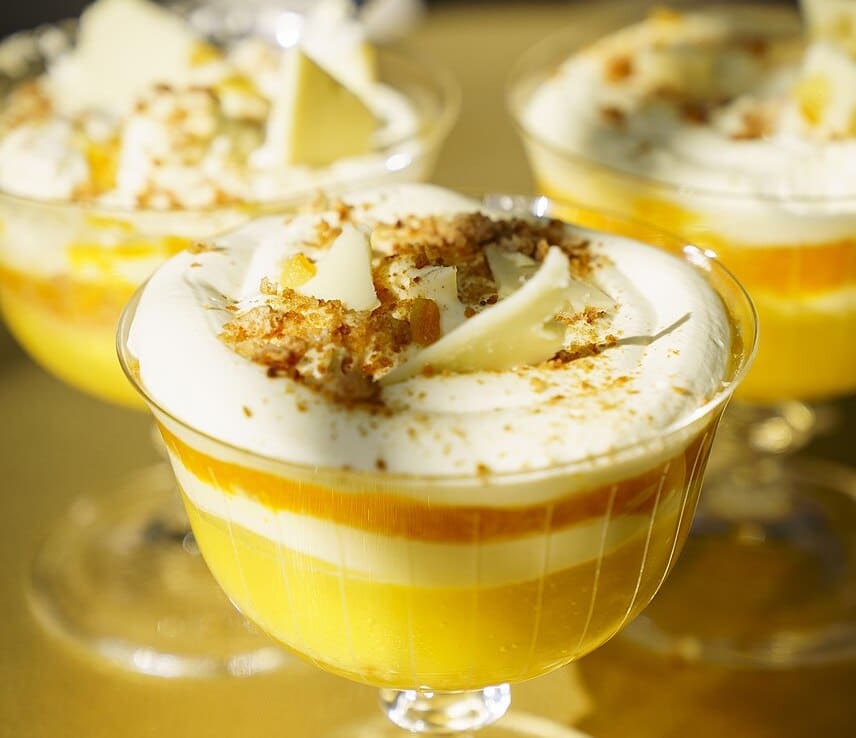Trifles are one of my favourite things. Given that I’m often faced with the task of mass catering, trifles are the easiest of puddings. They’re cheap to make, and, with the exception of the lactose intolerant, universally popular. Over the years I’ve experimented with different recipes – changing the sponge, fruit and custard. When we celebrated the Platinum Jubilee in 2022, I of course made the Jubilee trifle, but found it a little lacklustre, especially for the work that had to be put in. It was also alcohol-free. With a few tweaks – replace the St Clement’s jelly with Campari jelly and drench the sponge in Cointreau – the whole thing worked much better.
Some of our Dominican sisters live close by our priory in Cambridge, and they join us for daily Mass and celebrate important feast days with us. By tradition, they join us on Christmas Day for Mass and lunch. During the course of the meal last year, conversation turned to puddings. One of the sisters had prepared a trifle according to a traditional Anscombe family recipe, but this led to a dispute. What are the proper constituent ingredients of a trifle?
For the purists among our number, trifle was strictly limited to sponge, sherry, custard and cream, with the possibility of jam if absolutely necessary. They admitted the possibility of fruit, but even this was dubious, and would push the pudding away from the category of trifle towards something the sister’s family apparently called a “baffle”. When I raised the question of jelly, this was a step too far – it seemed to some of my company that the presence of such a foreign object in a trifle was of such gravity that Pius IX should really have included it in the Syllabus of Errors.
It didn’t take long for the spectre of nominalism to raise its ugly head, with the suggestion that trifle was just a name that we gave a series of puddings which have nothing in common except the name we give them. Such a view was roundly rejected, and another suggestion was made: could trifles be like angels, each a different species? While certainly a fan of trifle, I rejected this on the basis that no trifle – no matter how good – could be considered part of the angelic realm. In the end, we settled on the idea of genus and species. I permitted the possibility that traditional Anscombe trifle could stand at the head of the genus, which each species of trifle located within.
Whatever your views – whether you are a sherry trifle purist, or, like me, a wild experimenter with the genus of trifle – they’re perfect for any time of year.
<strong>Improved Platinum Jubilee trifle</strong>
You can follow the original recipe online for the trifle itself. In all honesty, when I made it I purchased many of the ingredients. After all, who has time to make their own Swiss roll or amaretti biscuits? For my version you will need:
<em>Lemon Swiss roll (if you can’t find this, lemon drizzle cake works fine)<br>2 tins of mandarins (around 300g each)<br>Cointreau<br>Gelatine leaves (enough for 550ml liquid)<br>200ml orange juice<br>300ml Campari<br>2 tbsp caster sugar<br>425ml double cream<br>3 large eggs<br>25g caster sugar<br>1 tbsp cornflour<br>zest of an orange<br>juice of an orange<br>600ml double cream (yes, a second, larger tub)<br>amaretti biscuits</em>
Cut up the lemon Swiss roll and arrange it in the bottom of a trifle bowl; add the tinned mandarins and douse with Cointreau. Soften the gelatine leaves in cold water, following the instructions on the packet. In a saucepan bring the orange juice to a simmer, add the sugar, and then add the gelatine. Once it’s cooled a little, add it to the Campari and then pour over the sponge and mandarins.
To make the custard, pour the smaller tub of cream in a saucepan and bring it to a simmer, stirring occasionally. Combine the egg yolks, sugar, cornflour and orange zest in a bowl, and then gradually add the hot cream, whisking continuously. Return everything back to the saucepan, whisking over a gentle heat until smooth and thickened. Stir in a couple of tablespoons of juice from the orange. Pour the custard into a jug or bowl until it has cooled and then add it to the trifle.
Whisk the larger tub of double cream, adding a little Cointreau. Once it’s all whisked, arrange it on top of the trifle and top the whole thing off with the amaretti biscuits, crushed. <em>Prego</em>!



